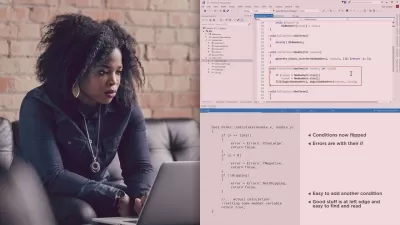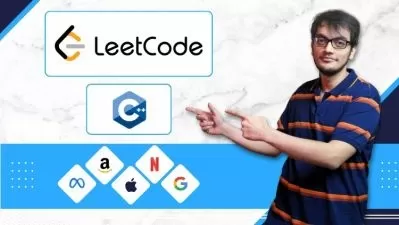Comprehensive C Programming Course
EDUCBA Bridging the Gap
27:39:46
Description
Master C programming and build real-world applications with our Comprehensive C Programming Course!
What You'll Learn?
- Introduction to C Programming: Gain a foundational understanding of C, its history, and why it's crucial in programming.
- Data Types and Variables: Learn about different data types, variable declaration, and usage in C programming.
- Control Structures: Master the use of control structures like if-else, switch-case, and loops (for, while, do-while) for decision making and iteration.
- Input/Output Functions: Understand and implement basic I/O functions to interact with users and perform data input and output operations.
- Operators: Learn to use various operators (arithmetic, logical, unary) to manipulate data and perform calculations.
- Arrays and Pointers: Understand the concepts of arrays and pointers, including one-dimensional and multi-dimensional arrays, and pointer arithmetic.
- Functions: Develop modular and reusable code by creating and using functions, including passing arrays to functions and handling return values.
- C Programming on Linux: Install and configure the GCC compiler, understand the compilation process, and learn debugging techniques on Linux.
- Practical Projects: Apply learned concepts in real-world projects such as developing an online exam portal and a payroll processing system.
- Problem Solving: Enhance problem-solving skills through various examples, case studies, and practice questions on arrays, pointers, and functions.
Who is this for?
What You Need to Know?
More details
DescriptionIntroduction
Welcome to the Comprehensive C Programming Course, a detailed and hands-on journey into the world of C programming. This course is designed to provide a solid foundation in C, covering fundamental concepts, advanced techniques, and practical projects. Whether you are a beginner looking to learn programming from scratch or an experienced developer seeking to enhance your skills, this course will equip you with the knowledge and confidence to write efficient and effective C programs.
Section 1: Fundamentals of C Programming
This section introduces the basics of C programming, starting with the history and significance of C. Students will learn about data types, variable declarations, and the overall structure of a C program. The section also covers basic input/output functions and control structures such as if-else statements, switch-case, loops (while, do-while, for), and the use of break and continue statements. By the end of this section, students will be comfortable writing simple C programs and controlling program flow.
Section 2: Advanced C Programming Techniques
Building on the fundamentals, this section delves into more advanced topics. Students will explore the use of operators, including logical and unary operators, and will solve problems using these operators. This section also covers arrays, pointers, and functions in great detail. Students will learn how to manipulate data using one-dimensional and two-dimensional arrays, perform pointer arithmetic, and implement various function types, including passing arrays to functions and returning values from functions. Case studies and practical examples will help solidify these concepts.
Section 3: C Programming on Linux
This section focuses on developing C programs in a Linux environment. Students will learn how to install and use the GCC compiler, understand GCC architecture, and explore various compiler options. The section covers the stages of compilation, variable types, arithmetic operators, control loops, and functions, with practical exercises to reinforce learning. By the end of this section, students will be proficient in writing, compiling, and debugging C programs on Linux.
Section 4: Project on C and POP - Online Exam Portal
In this project-based section, students will apply their C programming skills to create an online exam portal. They will learn how to create a menu-driven interface, implement various functions for saving and retrieving data, and understand score generation and output. This hands-on project will provide practical experience in developing a complete application using C.
Section 5: Project on C Programming - Payroll Processing
This section involves developing a payroll processing system. Students will create modules for the main menu, monthly transaction processing, and pay slip generation. This project will help students understand the application of C programming in real-world business scenarios, reinforcing their understanding of data management and processing.
Section 6: Project in C Programming - Employee Management System
In this project, students will build an employee management system. They will create and manipulate data structures, implement selection menus, and perform operations such as adding, modifying, and deleting employee records. This section emphasizes the practical use of C programming for managing data and developing user-friendly interfaces.
Section 7: Project in C Programming - 2 Players Tic-Tac-Toe Game
Students will develop a 2-player Tic-Tac-Toe game in this section. They will create the game board, accept player input, and determine the game outcome. This project will help students understand game logic and improve their problem-solving skills using C.
Section 8: Project in C Programming - Hangman Game
The final project involves creating a Hangman game. Students will implement a choice menu, select random words, hide words, evaluate player guesses, and create the main game loop. This project will consolidate their understanding of C programming concepts and provide a fun and interactive way to practice coding.
Conclusion
The Comprehensive C Programming Course offers an in-depth exploration of C programming, from fundamental concepts to advanced techniques and practical projects. By the end of this course, students will have a thorough understanding of C programming and the ability to develop complex applications. This course is perfect for anyone looking to build a strong foundation in programming and enhance their coding skills.
Who this course is for:
- Beginners in Programming: Individuals with no prior programming experience who want to start their journey in software development.
- Students: High school or college students looking to strengthen their understanding of C programming for academic purposes.
- Aspiring Software Developers: Those aiming to build a strong foundation in programming concepts before moving on to more advanced languages and frameworks.
- Professionals Seeking a Career Change: Professionals from non-technical backgrounds who wish to transition into a career in software development.
- Engineering Students: Students pursuing degrees in computer science, electronics, or related fields, who need a solid understanding of C programming.
- Hobbyists: Enthusiasts who enjoy coding and wish to add another programming language to their skillset.
- Self-Learners: Individuals who prefer self-paced learning and want to gain proficiency in C programming.
- IT Professionals: IT professionals looking to enhance their programming skills and knowledge of the C language.
- Embedded Systems Developers: Developers interested in or working with embedded systems where C is commonly used.
- Anyone Interested in Programming Fundamentals: Anyone who wants to understand the core principles of programming through one of the most widely-used and fundamental programming languages.
Introduction
Welcome to the Comprehensive C Programming Course, a detailed and hands-on journey into the world of C programming. This course is designed to provide a solid foundation in C, covering fundamental concepts, advanced techniques, and practical projects. Whether you are a beginner looking to learn programming from scratch or an experienced developer seeking to enhance your skills, this course will equip you with the knowledge and confidence to write efficient and effective C programs.
Section 1: Fundamentals of C Programming
This section introduces the basics of C programming, starting with the history and significance of C. Students will learn about data types, variable declarations, and the overall structure of a C program. The section also covers basic input/output functions and control structures such as if-else statements, switch-case, loops (while, do-while, for), and the use of break and continue statements. By the end of this section, students will be comfortable writing simple C programs and controlling program flow.
Section 2: Advanced C Programming Techniques
Building on the fundamentals, this section delves into more advanced topics. Students will explore the use of operators, including logical and unary operators, and will solve problems using these operators. This section also covers arrays, pointers, and functions in great detail. Students will learn how to manipulate data using one-dimensional and two-dimensional arrays, perform pointer arithmetic, and implement various function types, including passing arrays to functions and returning values from functions. Case studies and practical examples will help solidify these concepts.
Section 3: C Programming on Linux
This section focuses on developing C programs in a Linux environment. Students will learn how to install and use the GCC compiler, understand GCC architecture, and explore various compiler options. The section covers the stages of compilation, variable types, arithmetic operators, control loops, and functions, with practical exercises to reinforce learning. By the end of this section, students will be proficient in writing, compiling, and debugging C programs on Linux.
Section 4: Project on C and POP - Online Exam Portal
In this project-based section, students will apply their C programming skills to create an online exam portal. They will learn how to create a menu-driven interface, implement various functions for saving and retrieving data, and understand score generation and output. This hands-on project will provide practical experience in developing a complete application using C.
Section 5: Project on C Programming - Payroll Processing
This section involves developing a payroll processing system. Students will create modules for the main menu, monthly transaction processing, and pay slip generation. This project will help students understand the application of C programming in real-world business scenarios, reinforcing their understanding of data management and processing.
Section 6: Project in C Programming - Employee Management System
In this project, students will build an employee management system. They will create and manipulate data structures, implement selection menus, and perform operations such as adding, modifying, and deleting employee records. This section emphasizes the practical use of C programming for managing data and developing user-friendly interfaces.
Section 7: Project in C Programming - 2 Players Tic-Tac-Toe Game
Students will develop a 2-player Tic-Tac-Toe game in this section. They will create the game board, accept player input, and determine the game outcome. This project will help students understand game logic and improve their problem-solving skills using C.
Section 8: Project in C Programming - Hangman Game
The final project involves creating a Hangman game. Students will implement a choice menu, select random words, hide words, evaluate player guesses, and create the main game loop. This project will consolidate their understanding of C programming concepts and provide a fun and interactive way to practice coding.
Conclusion
The Comprehensive C Programming Course offers an in-depth exploration of C programming, from fundamental concepts to advanced techniques and practical projects. By the end of this course, students will have a thorough understanding of C programming and the ability to develop complex applications. This course is perfect for anyone looking to build a strong foundation in programming and enhance their coding skills.
Who this course is for:
- Beginners in Programming: Individuals with no prior programming experience who want to start their journey in software development.
- Students: High school or college students looking to strengthen their understanding of C programming for academic purposes.
- Aspiring Software Developers: Those aiming to build a strong foundation in programming concepts before moving on to more advanced languages and frameworks.
- Professionals Seeking a Career Change: Professionals from non-technical backgrounds who wish to transition into a career in software development.
- Engineering Students: Students pursuing degrees in computer science, electronics, or related fields, who need a solid understanding of C programming.
- Hobbyists: Enthusiasts who enjoy coding and wish to add another programming language to their skillset.
- Self-Learners: Individuals who prefer self-paced learning and want to gain proficiency in C programming.
- IT Professionals: IT professionals looking to enhance their programming skills and knowledge of the C language.
- Embedded Systems Developers: Developers interested in or working with embedded systems where C is commonly used.
- Anyone Interested in Programming Fundamentals: Anyone who wants to understand the core principles of programming through one of the most widely-used and fundamental programming languages.
User Reviews
Rating
EDUCBA Bridging the Gap
Instructor's Courses
Udemy
View courses Udemy- language english
- Training sessions 196
- duration 27:39:46
- Release Date 2024/10/12











